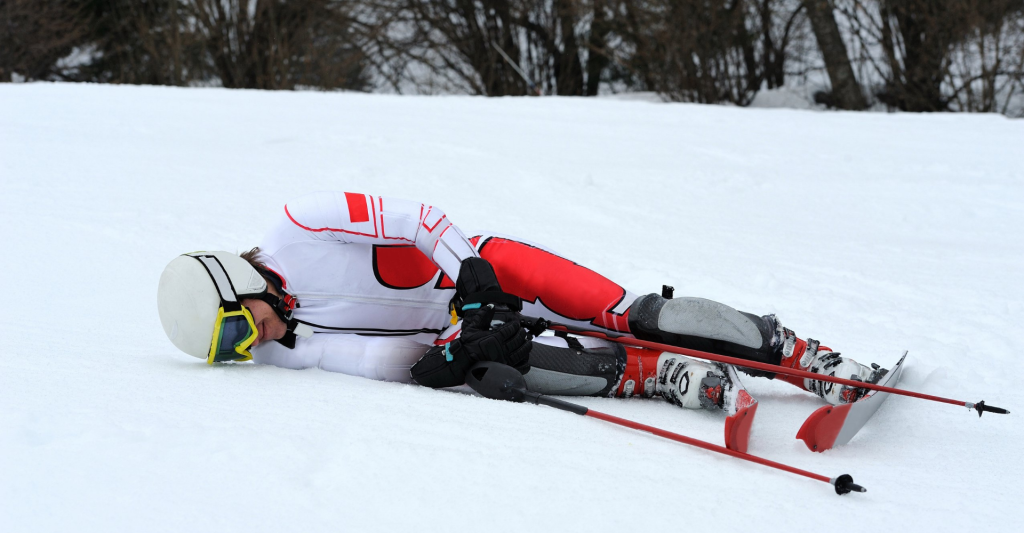Anterior cruciate ligament rupture (= cruciate ligament rupture) is one of the most common sports injuries. Around 80% of the normal population can return to sport after a cruciate ligament injury, but only around 55% of athletes return to their previous sporting level. Constant ligament instability, particularly during sporting activity, leads to premature wear of the cartilage and meniscus and thus to joint degeneration over time. The anterior cruciate ligament is particularly at risk when skiing.
What is a cruciate ligament?
A complex interplay between bones, ligament complexes, muscle attachments and tendons stabilize the joint even under maximum load, e.g. during sport. A simplified distinction is made between 4 main ligaments which protect the knee against rotation and axial tilt.
The anterior cruciate ligament runs diagonally through the knee joint, originates from the inside of the lateral (= outer) femoral condyle and attaches centrally to the tibial plateau (eminentia intercondylaris). It consists of 2 main bundles: the anterolateral and the postermedial bundle. Depending on the degree of flexion of the knee joint, the bundles are tensioned to different degrees.
The anterolateral bundle is probably mainly responsible for preventing anterior translation (= advancement of the tibial plateau in relation to the femur) of the tibial plateau. Inhibition of internal rotation is attributed to the significantly shorter postermedial bundle.
The cruciate ligament lies in the middle of the knee joint and is surrounded by synovial fluid (= joint fluid). For this reason, no blood clot can form, which would be so important for healing. Spontaneous healing of the ligament is therefore almost impossible.
Cruciate ligament rupture while skiing
Skiers between the ages of 15 and 25 are most frequently affected, as at this age there is a greater willingness to take risks combined with higher speeds. Female athletes are up to 5 times more likely to suffer a cruciate ligament injury than males. This is attributed to weaker connective tissue, but also to a more frequent knock-knee.

On the one hand, there is an increased risk of injury due to ski slopes being increasingly prepared with artificial snow, but also due to faster modern equipment. High-waisted carving skis allow the ski to pull outwards slightly in uncontrolled moments. The body’s center of gravity is usually further back, the knee joint is slightly bent and the shin is rotated inwards in relation to the thigh. This is known as the phantom foot mechanism, which often results in a cruciate ligament rupture.
Twisting trauma in a so-called “slip catch” also carries a high risk of injury. However, this mostly affects racers. Due to excessive load on the inner ski, the outer ski slips away (slip) and catches again in the snow through an acrobatic maneuver. The forces acting on the inner edge of the outer ski lead to flexion of the extended knee joint with simultaneous internal rotation and valgus maneuver (knock-knee).
However, the cruciate ligament can also tear during classic “threading” through a valgus (=X-leg) and through external rotation.

How do I recognize a cruciate ligament rupture?
Some athletes feel a snap, which can already indicate a cruciate ligament rupture. Often the run is still completed, the knee joint often swells with a time delay. A hemarthrosis (= bloodyeffusion of the joint) indicates a torn anterior cruciate ligament until proven otherwise.
In the course of the disease, instability can occur “giving way attacks” in which there are rotational movements between the thigh and lower leg which, if left untreated, lead to the destruction of the meniscus and cartilage tissue.
Clinical examination by a specialist remains essential. With various clinical tests (Lachman test, pivot shift test, anterior drawer) can be used to evaluate the stability of the cruciate ligament and the entire knee joint.
Radiologically, a magnetic resonance imaging (MRI ) scan is required to confirm the clinical diagnosis and to visualize the tear and any accompanying injury.
Treatment of cruciate ligament rupture
Depending on the patient’s age, sporting ambitions, profession and additional concomitant injuries, the decision on therapy is discussed individually with the patient.
There are 3 therapeutic options:
- Conservative therapy
- Surgical cruciate ligament refixation (cruciate ligament suture)
- Surgical cruciate ligament replacement
Conservative cruciate ligament rupture treatment
Patients with low sporting demands, advanced age, pre-existing osteoarthritis osteoarthritis (= joint wear and tear) benefit from conservative therapy in the absence of instability. This consists primarily of physiotherapy, building up the knee flexor muscles and proprioceptive training.
Regular evaluation of knee stability, muscular status and proprioception are essential.
Cruciate ligament suture
The success of a cruciate ligament suture depends on the patient’s age, the time of the injury and the location of the tear. Only cruciate ligaments that are torn directly from the bone show good long-term results. Tears in the middle of the ligament should rather be treated with a replacement.
The timing is crucial! Only injuries that are reattached to the bone in the first 3 weeks are promising. In addition, current data show that the probability of a cruciate ligament suture failing again is higher than that of a cruciate ligament plastic tearing again. Therefore, it is better to refrain from cruciate ligament sutures in young athletes.
Cruciate ligament plastic surgery
Arthroscopic cruciate ligament replacement surgery is considered the “gold standard” in the surgical treatment of cruciate ligament ruptures. This means that it is the standardized and most proven treatment option.
In arthoroscopic cruciate ligament surgery, a tendon from the patient’s own body is removed and then inserted as a new cruciate ligament in place of the torn one (cruciate ligament replacement surgery).
The tendon obtained is then inserted into short pre-drilled channels in place of the original cruciate ligament and attached to the bone. There are various fixation mechanisms for this.

Rehabilitation
After a cruciate ligament injury, there is a higher risk of re-injury to the same knee, but also to the other knee. A cruciate ligament prevention program is therefore essential for further sporting activities.